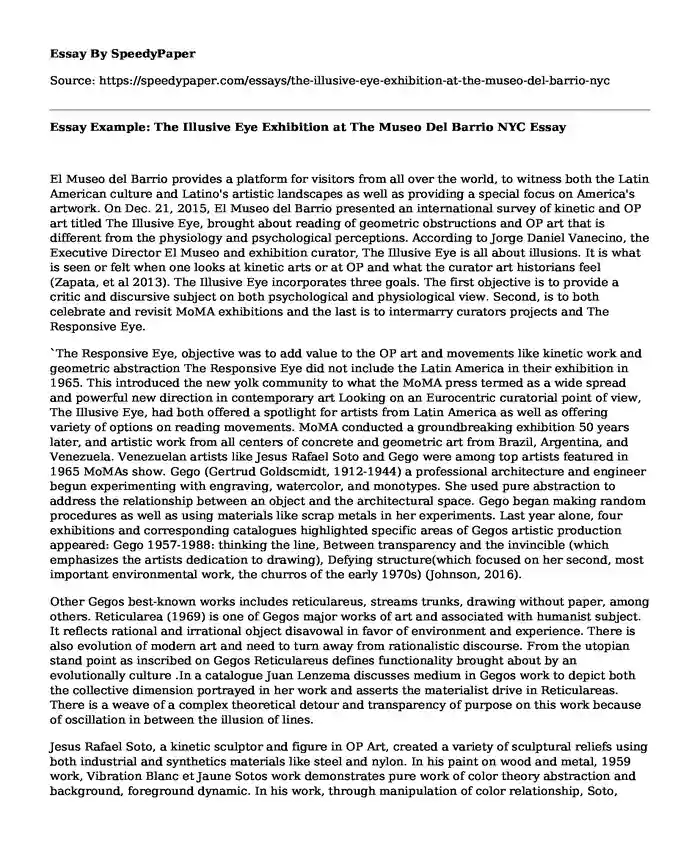El Museo del Barrio provides a platform for visitors from all over the world, to witness both the Latin American culture and Latino's artistic landscapes as well as providing a special focus on America's artwork. On Dec. 21, 2015, El Museo del Barrio presented an international survey of kinetic and OP art titled The Illusive Eye, brought about reading of geometric obstructions and OP art that is different from the physiology and psychological perceptions. According to Jorge Daniel Vanecino, the Executive Director El Museo and exhibition curator, The Illusive Eye is all about illusions. It is what is seen or felt when one looks at kinetic arts or at OP and what the curator art historians feel (Zapata, et al 2013). The Illusive Eye incorporates three goals. The first objective is to provide a critic and discursive subject on both psychological and physiological view. Second, is to both celebrate and revisit MoMA exhibitions and the last is to intermarry curators projects and The Responsive Eye.
`The Responsive Eye, objective was to add value to the OP art and movements like kinetic work and geometric abstraction The Responsive Eye did not include the Latin America in their exhibition in 1965. This introduced the new yolk community to what the MoMA press termed as a wide spread and powerful new direction in contemporary art Looking on an Eurocentric curatorial point of view, The Illusive Eye, had both offered a spotlight for artists from Latin America as well as offering variety of options on reading movements. MoMA conducted a groundbreaking exhibition 50 years later, and artistic work from all centers of concrete and geometric art from Brazil, Argentina, and Venezuela. Venezuelan artists like Jesus Rafael Soto and Gego were among top artists featured in 1965 MoMAs show. Gego (Gertrud Goldscmidt, 1912-1944) a professional architecture and engineer begun experimenting with engraving, watercolor, and monotypes. She used pure abstraction to address the relationship between an object and the architectural space. Gego began making random procedures as well as using materials like scrap metals in her experiments. Last year alone, four exhibitions and corresponding catalogues highlighted specific areas of Gegos artistic production appeared: Gego 1957-1988: thinking the line, Between transparency and the invincible (which emphasizes the artists dedication to drawing), Defying structure(which focused on her second, most important environmental work, the churros of the early 1970s) (Johnson, 2016).
Other Gegos best-known works includes reticulareus, streams trunks, drawing without paper, among others. Reticularea (1969) is one of Gegos major works of art and associated with humanist subject. It reflects rational and irrational object disavowal in favor of environment and experience. There is also evolution of modern art and need to turn away from rationalistic discourse. From the utopian stand point as inscribed on Gegos Reticulareus defines functionality brought about by an evolutionally culture .In a catalogue Juan Lenzema discusses medium in Gegos work to depict both the collective dimension portrayed in her work and asserts the materialist drive in Reticulareas. There is a weave of a complex theoretical detour and transparency of purpose on this work because of oscillation in between the illusion of lines.
Jesus Rafael Soto, a kinetic sculptor and figure in OP Art, created a variety of sculptural reliefs using both industrial and synthetics materials like steel and nylon. In his paint on wood and metal, 1959 work, Vibration Blanc et Jaune Sotos work demonstrates pure work of color theory abstraction and background, foreground dynamic. In his work, through manipulation of color relationship, Soto, creates optical effect through combination of black and creation of an interruption of white and yellow lines (Ramirez, 2005). Piet Mondrian an artist contemporary was among Russian constructivists who either impressed or were impressed by Sotos work. Being second to last of Sotos work Cubo y Estencion (Cube and Extension) in 1971
The Illusive Eye exhibition at Museo Del Barrio in New Yolk acted as an international survey of OP and kinetic arts that create a specific effect on artwork through optical illusion and movements. The Illusive Eye was dedicated to commemorate the 1965s MoMAs innovative exhibition though El Museos version came to elucidate the future of the Latin American artists including Jesus Rafael Soto and Gego (Gertrud Goldschmidt). Earlier in 1960s, The Responsive Eye was the only instrumental platform, and did not include the Latin American artists in the exhibition. The Illusive Eye introduced geometric abstraction and reading of the OP arts, which totally differs with physiology and psychology of perception, therefore offering a critical and discursive environment. Gego is a female artist who has highly flourished both in fields of sculpture and post war drawings. Reticularea (1969-1970), is among her best known artistic work, is evoked in tandem with a number of theoretical tropes like diagram, suture, purport, immanence, and rhizome. Jesus Rafael Soto, Cubo y Extension, 1971 a slightly dislocated and suspended cube made from same wires as the first. With this art, there is a connection between the viewer and the object; one cannot exist without the other.
eferences
Johnson, K. (2016). Op Art through a Latin Lens. Retrieved, from http://www.nytimes.com/2016/02/19/arts/design/op-art-through-a-latin-lens.html
Ramirez, Y. (2005). Nuyorican visionary. Retrieved, from http://centropr.hunter.cuny.edu/sites/default/files/Soto.pdf
Zapata, H. M., Simonetta, L. C., & Mansilla, M. L. (2013). El Museo Itinerante del Barrio de la Refineria: Renovacion museologica, memoria popular e identidad vecinal en Rosario (Argentina). Midas Midas, (2).
Cite this page
Essay Example: The Illusive Eye Exhibition at The Museo Del Barrio NYC. (2019, Sep 17). Retrieved from https://speedypaper.net/essays/the-illusive-eye-exhibition-at-the-museo-del-barrio-nyc
Request Removal
If you are the original author of this essay and no longer wish to have it published on the SpeedyPaper website, please click below to request its removal:
- Essay Example about Poverty in Children
- Healthcare Reform Paper Example
- Marketing Essay Example: Product Placement
- Domino's Pizza Essay Example
- Justification of Power of Absolute Monarch - Free Essay Example
- Free Essay Focusing on Literacy Programs for Oral Health Care for Older Adult
- Paper Example - Excellent Leadership Communication
Popular categories





